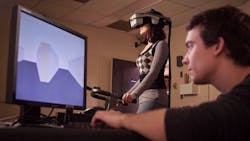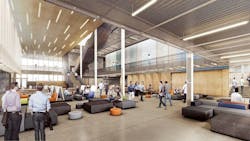Research in Cognitive Neuroscience on the built environment may change the way we see how people relate to the built environment. It may even change how we design.
In architecture, we often talk about designing for healing and learning, but what does this really mean for the people who use the spaces we create? We have great intentions for our designs, but beyond our years of professional experience, how do we know that a space is going to be experienced in the way we desire? Do we have the tools and metrics to back up our assertions about how our spaces will be used, and how they will be experienced?
Using a wide range of experimental methods and techniques, Vedran Dzebic, PhD candidate at the University of Waterloo, researches the complex relationships between how we think, feel, and behave in the built environment. Dzebic believes his research could become an important tool in the architect's toolbox– “standing alongside rather than in opposition to the creative process.”
Earlier this month, Dzebic presented his research to roughly three dozen architects, interior designers, and engineers at one of our Thursday night “Design Review” sessions in the Stantec Toronto office. Dzebic’s presentation, entitled “Cognitive Neuroscience: Understanding the Impact of the Environment on User” was well received; generating much discussion and debate within the office.
As a way of wrapping up the event, I’ve collected five thoughts on cognitive neuroscience and designing space:
It’s about people, not numbers
Sustainability took ten years to catch on, now it is embedded in virtually every project we produce. Sustainability has been a powerful force in the design community, but we must remember that it is not enough to simply reduce the energy consumption of our buildings. We must constantly strive to create environments that are people-focused—places that are comfortable and supportive. Applying cognitive research may be a way to help us create better, more user-focused spaces, and it may mark the beginning of the next wave of sustainable design.
Designers see differently than end users
During the presentation, Dzebic showed us a seemingly abstract black and white image (an image used by neuroscientist Earl K. Miller in his research). Normally, when giving similar presentations, Dzebic must explain to the audience that if you look closely, the image shows a dog and a tree. It is a lesson in the human capacity for pattern-seeking. Interestingly, our room of designers saw the embedded image immediately. Why such a difference between a standard audience and one full of designers? One possibility is that designers are trained in the visual realm, while the average audience members (and average clients) probably aren’t. This raises important questions: do our designs include elements that most of the population doesn’t notice? Should this affect how we design? Can we teach our clients to “see the dog?”
Visual Complexity is… Complex
As part of his presentation, Dzebic discussed some research on visual complexity. As designers, those in attendance immediately wanted to know if visual complexity was a good thing or a bad thing. It turns out that the answer is… it depends. As Dzebic explained, humans have a finite capacity of attention, and during experiments when these attentional resources are depleted, people struggle to perform tasks and experience negative emotions in complex visual environments. So, simple is better? Not so fast. Research has also shown that environments with low visual complexity can be “boring” for users, even causing a stress response. Ultimately, there is no right answer for visual complexity, it depends on the space and the behavior or emotional response that the designer is striving for. For example, as an educational designer, I will certainly be thinking about students and their finite capacity for attention. I wouldn’t want to create a space that is so complex that it makes it difficult for students to pay attention in class.
This is measurable science that we can apply in our design process
Dzebic’s experiments involve everything from asking subjects questions about a space to physiological measurements, including eye-tracking and even brain-wave monitoring. His research looks at the way space affects our brains and bodies. This measurable data can and will change how we design.
Tools for simulating spaces (such as virtual reality) are getting more sophisticated and increasing in fidelity with each passing year, and our BIM design process has us generating fully three-dimensional models as part of our normal design and documentation process. Imagine, rather than doing evaluations long after our design work is done, we can try to predict during the design process how our choices will affect people! We can ask our subjects what they think, but also use skin conductivity, eye tracking, heart rate monitoring, and other innovative methods to gauge their objective reactions to the space.
Over time, this process will get better, forming a continuous design feedback loop and this new-found knowledge will allow us to design ever-better spaces for our clients.
There will be pushback, but we can’t let that slow us down
Incorporating cognitive neuroscience and design evaluation might be the future of architecture, but there will be pushback. Some designers are hesitant to measure this human factor, perhaps because they feel that a scientific approach to our work is incongruous with the more intuitive and artistic aspects of design. Some are also no doubt concerned that research of this type might generate “rules” that will limit creative expression.
While I can understand these concerns, I take a very different view. I want to create the best possible environments for my clients, and we should be willing to explore any avenue to achieve that end. Collaboration between designers and environmental psychologists and cognitive neuroscientists is an opportunity to increase the rigor we apply to our designs, and will allow us to stand confidently behind our work.
Further, if anything I believe that this research only reinforces our conviction as designers that the spaces we create have profound impacts on the people who work and live within them. It confirms that our work is important, and reminds us that we have a responsibility to create the best possible environments for our clients.
It’s time for designers to get acquainted with cognitive neuroscience.
About the Author
Stantec
Published by global design firm Stantec, this eclectic blog features viewpoints, insights, and explanations from Stantec architects, engineers, and designers, on a range of issues impacting the fabric of our communities. Our contributors share their thoughts about design trends, emerging technologies, vexing challenges, and inspired solutions. For more blog posts, visit our Ideas page. Follow us on Facebook, Instagram, LinkedIn, and Twitter, and YouTube.

